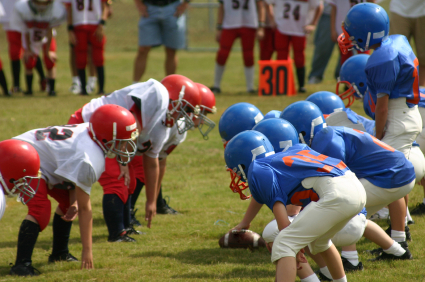Most boys need sports because they are hard-wired to compete and win. To understand why a successful sports experience is so critical to a boy's social and emotional development and why boys behave the way they do requires at least a rudimentary understanding of the science of evolutionary biology.
 Many of the ways boys behave - particularly their love of sports and rough and tumble play - are rooted in the distant past. Boys are hard-wired to form large social groups in which to compete against other boys and sort out winners and losers (like the game "King of the Hill") because their ancestors did the same thing during childhood and adolescence in preparation for the more serious competition - for food, for mates, to survive - they would face as adults. The rough-and-tumble play boys are so fond of, which experts say begins around age three and peaks between ages eight and ten, also contributes to formation of dominance hierarchies in boys' groups. A male's greater acceptance of - indeed attraction to - risk-taking may also explain why boys are, more than girls, attracted to extreme sports (skateboards, snowboards, rock climbing, BMX bikes etc.).
Many of the ways boys behave - particularly their love of sports and rough and tumble play - are rooted in the distant past. Boys are hard-wired to form large social groups in which to compete against other boys and sort out winners and losers (like the game "King of the Hill") because their ancestors did the same thing during childhood and adolescence in preparation for the more serious competition - for food, for mates, to survive - they would face as adults. The rough-and-tumble play boys are so fond of, which experts say begins around age three and peaks between ages eight and ten, also contributes to formation of dominance hierarchies in boys' groups. A male's greater acceptance of - indeed attraction to - risk-taking may also explain why boys are, more than girls, attracted to extreme sports (skateboards, snowboards, rock climbing, BMX bikes etc.).
An interesting 1987 study of boys attending summer camp found that boys, once assigned to cabins, organized themselves into teams led by the strongest, most athletic boys, and that once formed, the teams resulted in reduced conflict and led to an increase in sports competition with boys from other cabins. By the end of summer, the dominant boys were almost always spending time with their cabin-mates and spending most of their free time directing the group in competitive athletic activities.
Low Man on the Totem Pole
This evolutionary perspective may explain why boys on sports teams, more than girls, are able to figure out who should play what position and who should be captain without the help of the coach. It may also explain why boys seem to be more comfortable than girls in unequal relationships, even if they are the one who is "low man on the totem pole." A third-string linebacker is able to be the star quarterback's best buddy because he doesn't resent the quarterback's higher status.
As Dr. Leonard Sax observes in his book, Why Gender Matters, "This male characteristic has roots that go very deep. If you know the stories of Jesse and Jonathan son of Saul, or for that matter Don Quixote and Sancho Panza, then you've heard this story before. Those friendships were not less strong because of the difference in status between the friends. On the contrary, the hierarchical character of the relationship defined and even ennobled the friendship." Because boys, like their ancestors, recognize the importance of strong coalitions to their individual and collective survival, boys more than girls prefer to have the best players on their team, not necessarily their friends.
Learning social skills for adulthood
A 2003 article in Developmental Review suggests that one of the functions of team sports for boys is to help them develop the social skills needed to form competitive groups or coalitions in adulthood, such as business organizations. Many of these developmental activities also mirror and provide practice for specific behavioral skills associated with primitive warfare, such as throwing and tracking the trajectory of projectiles. This might explain why fathers seem so intent on spending so much time with their sons practicing throwing and catching - they are hard-wired to pass these skills on to their sons to prepare them for warfare - and seem far less interested in teaching their daughters these same skills.
The relation between physical aggression and social dominance becomes more obvious and serious in late childhood and early adolescence. Between ages 8 and 10, bullying by boys increases at the beginning of each school year and decreases later in year after the social pecking order is established. By grade school, boys' games are more competitive, longer in duration, with more rules and interdependence between players and with clear winners and losers. By contrast, girls avoid games where winning means someone must lose; they like turn-taking games like hopscotch, where competition is less direct. A 2002 study of fourth and six graders showed, during free time, that boys competed with boys half the time while only one percent of the girls used recess to compete against other girls.
The bottom line: your son is hard-wired to do many of the things that he does. Understanding that hard wiring will help you be a better parent.
Adapted from the book, Home Team Advantage: The Critical Role of Mothers in Youth Sports (HarperCollins ) by Brooke de Lench.de Lench is also the Founding Executive Director of MomsTeam Institute and the publisher of MomsTeam.com. Producer of: The Smartest Team: Making High School Football Safer (PBS) and is well known as the “Mother of Youth Sports Safety” for her tireless advocacy and solutions based work in safeguarding young athletes.









